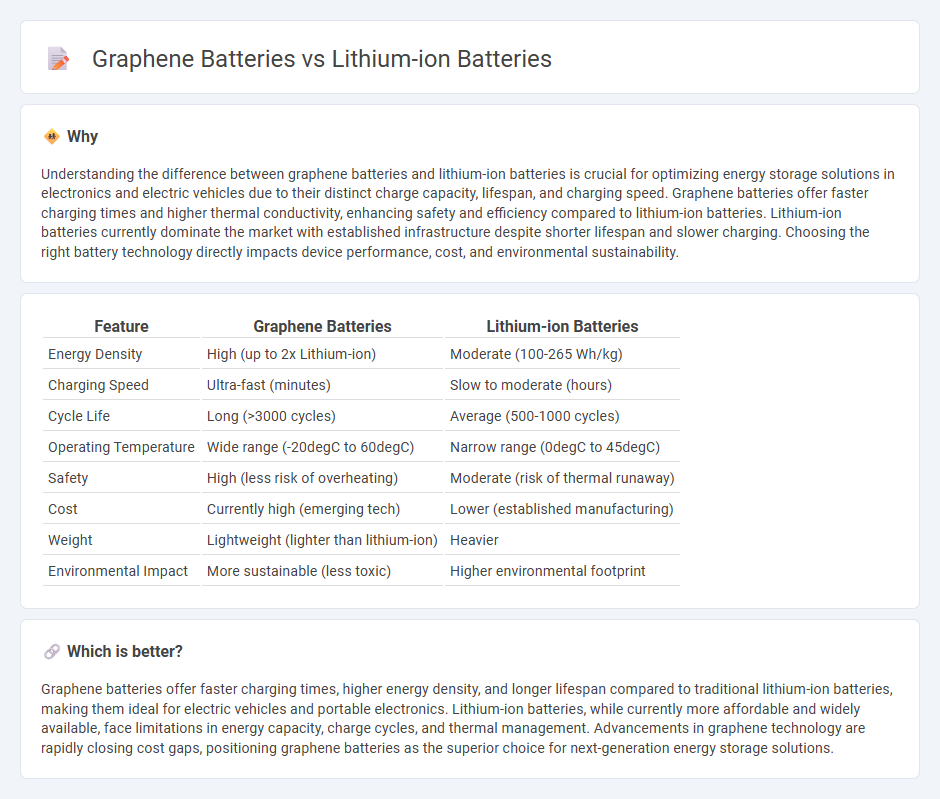
Graphene batteries offer faster charging, higher energy density, and longer lifespan compared to conventional lithium-ion batteries. Their enhanced thermal conductivity reduces overheating risks, improving safety and performance in electronic devices and electric vehicles. Explore the advancements in energy storage technology to understand how graphene batteries are transforming the future of power solutions.
Why it is important
Understanding the difference between graphene batteries and lithium-ion batteries is crucial for optimizing energy storage solutions in electronics and electric vehicles due to their distinct charge capacity, lifespan, and charging speed. Graphene batteries offer faster charging times and higher thermal conductivity, enhancing safety and efficiency compared to lithium-ion batteries. Lithium-ion batteries currently dominate the market with established infrastructure despite shorter lifespan and slower charging. Choosing the right battery technology directly impacts device performance, cost, and environmental sustainability.
Comparison Table
| Feature | Graphene Batteries | Lithium-ion Batteries |
|---|---|---|
| Energy Density | High (up to 2x Lithium-ion) | Moderate (100-265 Wh/kg) |
| Charging Speed | Ultra-fast (minutes) | Slow to moderate (hours) |
| Cycle Life | Long (>3000 cycles) | Average (500-1000 cycles) |
| Operating Temperature | Wide range (-20degC to 60degC) | Narrow range (0degC to 45degC) |
| Safety | High (less risk of overheating) | Moderate (risk of thermal runaway) |
| Cost | Currently high (emerging tech) | Lower (established manufacturing) |
| Weight | Lightweight (lighter than lithium-ion) | Heavier |
| Environmental Impact | More sustainable (less toxic) | Higher environmental footprint |
Which is better?
Graphene batteries offer faster charging times, higher energy density, and longer lifespan compared to traditional lithium-ion batteries, making them ideal for electric vehicles and portable electronics. Lithium-ion batteries, while currently more affordable and widely available, face limitations in energy capacity, charge cycles, and thermal management. Advancements in graphene technology are rapidly closing cost gaps, positioning graphene batteries as the superior choice for next-generation energy storage solutions.
Connection
Graphene batteries and lithium-ion batteries share a fundamental connection through their use of lithium-ion technology for energy storage, with graphene enhancing conductivity and charge efficiency. Graphene materials improve electrode performance by increasing electron mobility and thermal management, leading to faster charging times and longer battery life compared to traditional lithium-ion cells. This synergy drives advancements in portable electronics and electric vehicles, combining the established lithium-ion framework with graphene's superior material properties.
Key Terms
Energy Density
Lithium-ion batteries typically offer an energy density ranging from 150 to 250 Wh/kg, while graphene batteries can potentially exceed 300 Wh/kg due to their enhanced electron mobility and superior thermal conductivity. The higher energy density of graphene batteries translates into longer battery life and faster charging times, which is crucial for electric vehicles and portable electronics. Explore detailed comparisons and future advancements to understand the full potential of graphene technology in energy storage.
Charge/Discharge Rate
Lithium-ion batteries typically offer charge and discharge rates around 1C to 3C, balancing energy density and performance, while graphene batteries can achieve much higher rates exceeding 10C due to superior electrical conductivity and thermal management. This enhanced charge/discharge capacity allows graphene batteries to recharge in minutes and deliver more consistent power output under heavy loads. Explore further details on how these technologies impact electric vehicles and portable electronics performance.
Cycle Life
Lithium-ion batteries typically offer around 500 to 1,000 charge-discharge cycles before significant capacity loss, while graphene batteries can exceed 2,000 cycles thanks to enhanced conductivity and structural stability. The improved cycle life of graphene batteries reduces replacement frequency and overall lifecycle cost, making them ideal for electric vehicles and renewable energy storage. Explore more to understand how graphene technology can revolutionize battery performance and longevity.
Source and External Links
Lithium-ion battery - A rechargeable battery using lithium ions reversibly intercalated into solids, known for high energy density, efficiency, long cycle life, and widespread use in electronics and electric vehicles; developed since the 1970s and awarded the 2019 Nobel Prize in Chemistry for its inventors.
Lithium-Ion Battery - Clean Energy Institute - Li-ion batteries have high energy density (up to 330 Wh/kg), deliver voltages around 3.6 V, exhibit low maintenance, no memory effect, and low self-discharge, making them dominant in portable devices and electrified transportation like EVs and aircraft.
How Lithium-ion Batteries Work - Li-ion batteries consist of anode, cathode, separator, electrolyte, and current collectors; they operate by lithium ions moving between anode and cathode during charge and discharge, enabling lightweight, rechargeable power for electronics and vehicles.
 dowidth.com
dowidth.com